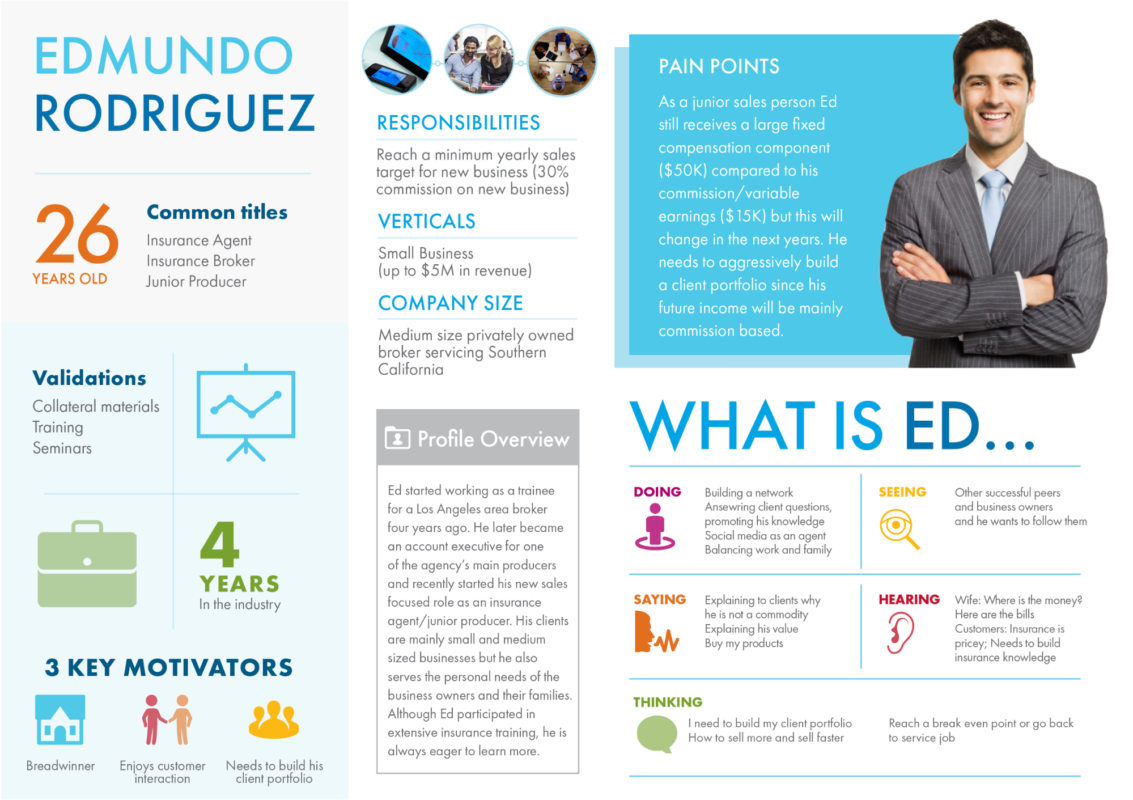What exactly is copywriting? Copywriting is the art and science of writing copy (words used on web pages, ads, promotional materials, etc.) that sells your product or service and convinces prospective customers to take action. In many ways, it’s like hiring one salesman to reach all of your customers. A sales team contacts customers one at a time; a copywriter reaches all of them at once through billboards, magazine ads, sales letters, blog posts, and more.
Design, content marketing, SEO, and growth hacking are all parts of a complete digital marketing plan, but copywriting is the glue that ties it all together. Copy gives your design meaning and lays the foundation for your content marketing, SEO, and growth hacking. Writing better copy enables you to convert more readers into customers, and we wanted to provide a guide that would give you an advantage when writing copy both on and offline.
If you can leverage your writing to tell a compelling story while convincing customers of the need for your product, there is no limit to the growth your business can experience.
However, if you are stuck writing generic emails, ads, and sales letters, you can expect to spend the rest of your entrepreneurial career struggling to make a single sale.
But how in the world do you actually become a good copywriter?
- Should you spend countless hours handwriting famous sales letters?
- Should you read hundreds of books on copywriting?
- Should you go to college and spend $100k on yet another advanced degree?
I think there is a better way to become a world-class copywriter—an easier way that requires almost no investment from you and that will only take you about 30 days.
The first thing I want to point out is that this article is designed to help you become a world-class copywriter, not a master copywriter.
To become world-class (the top 5%) takes only about a month of focused, intentional work.
Breaking through those extra four percentile points to become a true master copywriter (the top 1%) will take you years, if not decades, of practice and dedication.
However, unless your entire career is dedicated to copywriting, all that effort is unnecessary. If you can break out of the realm of good copywriting and become great, the extra four percentage points are simply not needed to run a successful business.
Becoming world-class is completely achievable and can be done faster than you think.
Let’s begin.
Why Understanding the Product Is So Important
The first step in any copywriting project is fully understanding whatever product you’re selling. David Olgilvy, a legendary copywriter, is famously known for taking three weeks of meticulous study to come up with a winning concept for a Rolls-Royce ad. The final headline read “At 60 miles per hour the loudest noise in this Rolls-Royce comes from the electric clock.” It took him that much time to find a detail compelling enough to sell a Rolls-Royce.

And if it took Mr. Ogilvy that long to discover such an important selling feature, it’s surely worth taking some time to study your product to learn which features will stand out to your customers. That’s the real goal of this chapter — to find out what makes your product unique and what benefits and features will appeal to your customers.
This is step one for any copywriting project.
The good news is that as a business or blog owner, you already know your product inside and out. You know the features, understand how it works, and are familiar with the benefits it provides your customers. This offers a great starting point for writing copy. Instead of needing to do in-depth research, you can begin by writing down what you already know. You won’t need to spend hours researching the product and taking notes.
On the other hand it’s still worthwhile to follow the steps in this chapter in order to capture all of the details of your product. By writing down a complete product description along with a list of the features and benefits, you’ll save this important information where you can refer back to it in later chapters. It’s better to have everything saved in one place so you’ll always have it available at your fingertips.
So before you start writing copy, complete the following exercise to write down a description of your product or service. After finishing, you’ll know every detail of what you’re selling and have a better idea about how to sell it.
Create Your Product Description – Copywriting
Get started by answering the following questions about your product (questions may need to be tweaked slightly if you’re providing a service instead of selling a product).
For the sake of illustrating each step of the process, we’ll create a hypothetical product that we can reference throughout this guide that is titled “Simple Survey Tool.”
Question 1: How would you describe the product?
For this question, provide a simple, two to three sentence description of the product. It doesn’t need to be super long or detailed and don’t worry about providing a fancy answer. Simply write down a short description as if you were describing the product to a customer.
Sample answer:

Question 2: What’s unique/special about this product?
The goal here is to identify something unique or special about the product. What does this product offer that others don’t? Is it made in the USA? Is it easy to install? Does it provide analytics that other sites don’t offer?

Eventually, you’ll use this to identify a unique selling proposition (USP). A USP is something unique that other companies don’t offer. Is there something special about your product? Is there something that makes it stand out from the competition? Record anything here about the product that makes it special or unique.
Sample answer:

Question 3: What big benefit does it provide?
Not only do you want to know how a product is unique, but you also know what benefit it provides customers. Many companies stop at describing the product and don’t go on to conveying the benefit of using it.
For example, a company may talk about how they offer web analytics software but don’t tell customers about the benefit of using the service. Instead, they should tell customers that the software helps them build a more profitable site, generate more revenue per customer, or accomplish something else along these lines. The focus should be on providing a benefit, not just describing the service.
So what big benefit does your product provide?
Sample answer:

Question 4: What pain does it alleviate?
People generally buy for one of two reasons — to increase their pleasure or to minimize pain. In the question above, we identified the benefit that would “increase pleasure;” in this question, we’ll identify which pain is minimized by using the product.

For example, a car insurance company could use a headline like this: “Are You Paying Too Much for Your Car Insurance?” The ad would then go on to talk about how most customers pay more than they need for car insurance, and how company X can save them more money (which is something similar to what GEICO currently does). The purpose of the ad is first to focus on the pain, and then to talk about how Company X alleviates that pain.
Another option is to focus the ad on the pleasure customers experience from saving money. It could use a headline like this: “How Will You Spend the Money You Save Using [Specific Car Insurance Company Name Here]?” Instead of focusing on the pain, it draws attention to the pleasure experienced by switching to a different insurer (which is what GEICO did in 2008 with their “the money you could be saving” ads).
Often, focusing on the pain eliminated is more effective than focusing on the pleasure provided, but both approaches can be tested to evaluate their effectiveness.
So what pain does your product alleviate? Let’s write that down now.
Sample answer:

Question 5: What features are included and what are the benefits of each?
The first thing you want to do to answer this question is write down each of the product’s features. You may not end up using all of them in your copy, but at the very least, you want to record them all in one place so you have them at your fingertips if needed. Some products have a lot of features, others have less. Either way, list all of your product features here with a short description of each.
In addition to listing the features, be sure to list the benefit of each. We’ll talk more about benefits later, but in short, customers care more about benefits provided by features than the features themselves (but you still may need to list the features in your copy so be sure to record them all here).
For example, customers care more about high speed internet that helps them watch streaming videos without interruption than internet that provides 15 mbps download speeds. The “15 mbps” is a feature, in this case, and “streaming videos without interruption” is the benefit provided by the feature. Record the features of your product and the corresponding benefit now.
Sample answer:
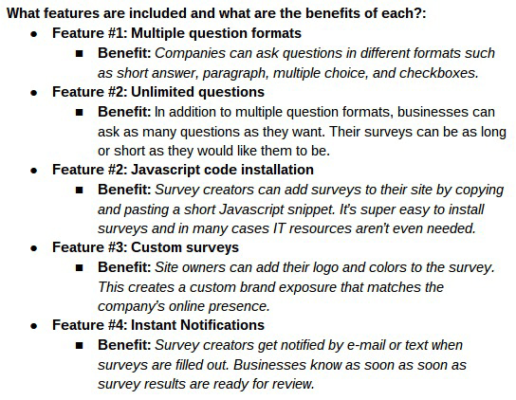
As you can see from these sample answers, there’s a big difference between features and benefits. Features are the technical aspects of the product, and the benefits are the way those features help customers accomplish something they want to accomplish. It’s good to record both, but we’ll talk more about the importance of benefits in a later chapter.
Now that we’ve taken some time to understand your product and record it’s features, let’s move on to the other critical step in the copywriting process.
2. Understand Your Customers – Copywriting
Next to understanding the product inside and out, the most important step in any copywriting project is knowing who you’re selling to. Here’s why.

How you sell whatever you’re selling is determined by who you’re selling it to, what they want to buy, and what will convince them to make a purchase. It’s all about the customer, not your company.
If you’re selling to stay-at-home moms, you’re going to write differently than if you’re selling to high-net-worth business executives, and if you’re selling to Fortune 500’s, you’re going to write differently than if you’re selling to startups.
You may be wondering, “Why is this so important?” It’s important because each group of customers has different hopes, fears, dreams, and expectations. Moms, for example, have different priorities than business executives. Saving money is more important for moms, whereas saving time is more valuable to executives.
These differences influence the way you write and how you sell the product. It also means you really need to know what appeals to your customers.

So as you can see, defining your customer is a critical part of the copywriting process.
Understanding your audience and their fears, wants, and needs is the first step to writing great copy.
How do you do this?
First, put yourself in their shoes. This should be relatively easy if you are selling a product that solves a problem you once had.
For example, my company Crazy Egg helps entrepreneurs figure out why customers are leaving their websites. Quite frankly, it’s easy to write copy to sell my services because I used to struggle with the same problem.
There are no hypotheticals or guesswork involved when I am writing posts for The Daily Egg. It’s like biking downhill. No effort. I know the pain of having a high bounce rate; I know how it affects people’s businesses; and I know how to fix it. This makes it easy for me to speak to other entrepreneurs facing the same issues.
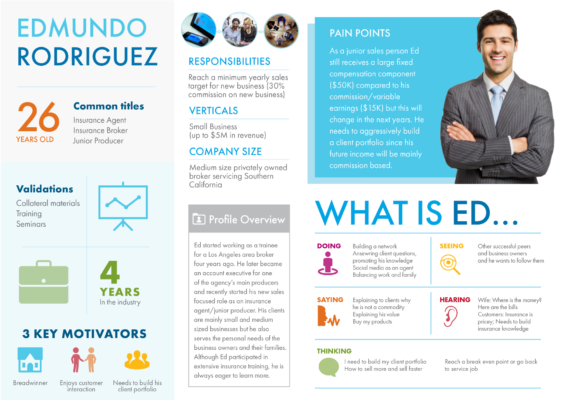
However, if you are selling a product or service you would not use yourself (a common problem among freelance copywriters), you need to gain more knowledge about the issue.
This is where customer surveys are a lifesaver. Instead of having to guess what your customers are looking for, just ask them directly.
Ideally, you’ll have some sort of marketing persona already created and can use this to target your customer.
If you are not working directly with your final client (for example, if you are a ghostwriter or run a copywriting firm), make sure to find a way to survey the end user.
This will allow you to gain deep insights into what your audience is looking for whenever you are writing your copy.
Copywriting Do Customer Research
Answer these 4 questions (again, the questions will need to be modified slightly for service businesses):
Question 1: Who currently buys your product?

The first question identifies who your current customers are. You may be selling to both startups and Fortune 500’s, but whatever the case may be, it’s important to know who your current customers are because you need to know who pays your bills. (If you haven’t started selling anything yet, skip this question and move on to the next one.)
Sample answer:

Question 2: Who would you like to buy your product?
This second question identifies who you would like to be selling to. As mentioned above, you may be selling to startups and Fortune 500’s, but you’d rather focus on the Fortune 500’s because they have larger budgets and are less likely to be price conscious.copywriting
It’s ok to sell to both, but if you’d like to target one over the other, you’ll end up writing your copy differently. That’s why it’s important to know exactly who you’re selling to and who your target customers are.
Sample answer:

Question 3: What does a typical customer look like?
The goal of this question is to create a detailed picture of your typical customers. The other questions create an overview in broad brushstrokes, but this question zooms in on individual customers. We’re zeroing in on a handful of real customers in order to find out what’s important to them.
Sample answer:
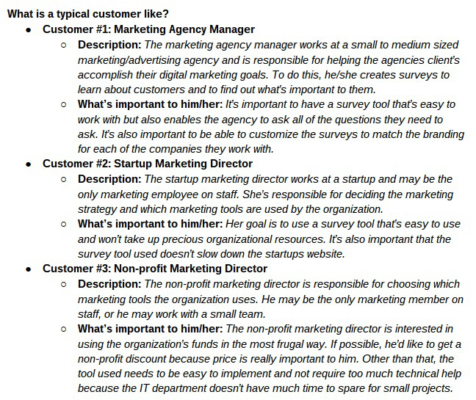
Question 4: What do customers love about your product?
In addition to needing to know who your customers are, you also need to know what delights them about your product. Why did they buy in the first place, and why do they keep coming back?
Prius owners, for example, buy because they’re interested in doing their part to save the environment. That’s more important to them than how the car looks. So Toyota is smart to play up that angle and not to focus on how sexy the car is (which is good because Prius’s aren’t the best looking cars on the road).copywriting
BMW owners, on the other hand, care less about the size of their carbon footprint and more about their self image. They want a car that makes them appear successful and elite. Their image is more important than gas mileage, and that’s why they buy a BMW in the first place.
With both of these examples, the copy needs to focus on what appeals the most to the target customers and what they love the most about the product. This will be different for every product, even within the same industry.
So take a minute and reflect on the main reasons people buy your product. What do they love about it? Once you’ve figured it out, record your answer in the document.
Sample answer:
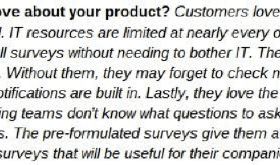
At this point, you should have a good idea of:
- How to describe your product or service in a simple yet understandable way
- The main features and benefits of your product/service
- The big benefit, i.e. the main selling point(s) of your product/service
- Who your customers are and what matters to them
The notes you’ve taken up to this point will provide a solid foundation for the copy you’ll write.
Write attention-grabbing headlines
Headlines can make or break your copy.
It doesn’t matter whether you are writing for ads, a website redesign, Facebook posts, or landing pages. Headlines convince readers to click on your article and give your copy a fighting chance.
How do you write attention-grabbing headlines? copywriting There are 3 keys to attention-grabbing headlines.
1. Your headlines should be unique
The Internet and advertising world are full of copycats and people who thrive on plagiarizing other people’s content.
Don’t be one of them.
If you want to stand out from the crowd and sell your products, you need to have unique, attention-grabbing headlines.
2. Your headlines should be extremely specific
As soon as your audience reads your headline, they should know exactly what they’ll receive from your product or service.
Steer clear of generic or ambiguous phrases, and describe what your potential customers will get very specifically (this is where the elevator pitch comes in handy).
3. Your headline should convey a sense of urgency
You want your audience to think about what they’ll lose if they don’t take immediate advantage of your product or service.
Are they losing clients? Are they missing out on potential social opportunities? Capitalize on people’s fears of missing out (FOMO), and your headlines will help your copy convert like crazy.
Write persuasive copy
Copywriting, when compared to other forms of writing, is a different kind of animal.
It’s not necessarily about writing well.
It’s about writing persuasively.
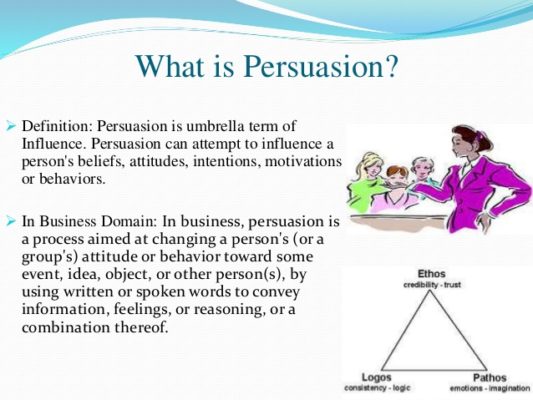
It doesn’t matter if you’re a world-class wordsmith or a literary genius.
If you can’t effectively move readers through the proper sequence of steps and ultimately convince them to buy, your conversions are going to suffer.
Here are my favorite copywriting tactics for converting traffic into paying customers.
Start with a killer value proposition – Copywriting
Research from Nielsen Norman Group found that you have a very small amount of time to grab a visitor’s attention before they leave your page.
In fact, you usually have a max of 20 seconds.
Your first order of business is to make it abundantly clear what your value proposition is.
Now, there are several ways to go about this, but I believe in keeping things simple.
Getting too complex tends to dilute the message and confuse prospects.
What I’ve found to be most effective is keeping my value proposition short, sweet, and clear.
Like this:

I think the Moz homepage does a really good job at this as well:
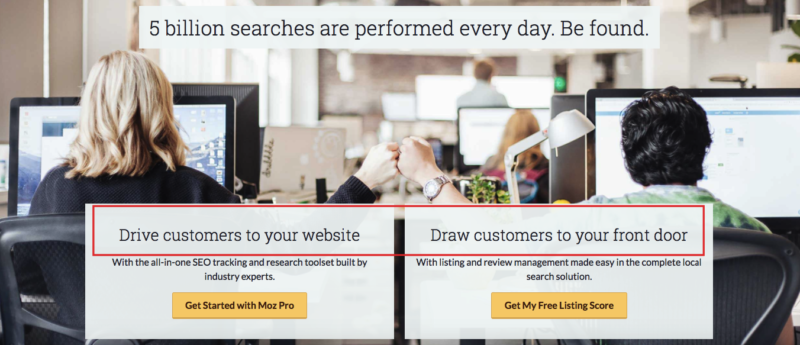
Don’t make them guess what you’re offering.
Let them know in a split second what you are offering with your crystal clear value proposition.
To accomplish this, try to condense the essence of your product down to just a few words.
Swiftly move to the benefits
“What’s in it for me?”
That’s what most visitors are thinking after hearing your value proposition.
But here’s the thing.
Most people have a tendency to emphasize features over benefits.
But it should be the other way around.
Just look at this Venn diagram from ABC Copywriting:
Notice that benefits are valued over features.
Of course, you need to explain how your product works. But you can elaborate on that later.
What you want to do first is explain how the product fulfills a need or desire.
In other words, explain how your customers’ lives will be better after they buy your product.
Here’s a great example from Moz:
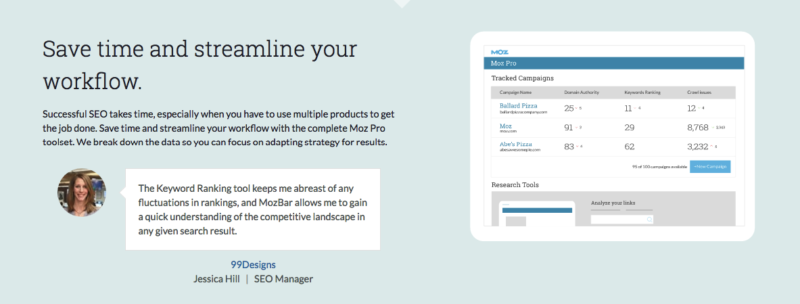
See how prospects instantly understand the benefits of using Moz?
It will save them time and make things more efficient.
They also don’t have to worry about deciphering complex data because Moz takes care of this for them.
When it comes to describing benefits, there are three main types to cover:
- Tangible
- Intangible
- Commercial
This illustration from ABC Copywriting explains these various types of benefits in more detail.
As they point out, “Benefits need not be unique, but they must be compelling.”
Keep this in mind when deciding on an angle.
I personally find that it’s best to highlight the benefits before getting down to the nuts and bolts of the features.
That way prospects should be more receptive and willing to wade through the details.
But if you go the other way around and cover the features before the benefits, you’re probably going to lose a sizable portion of your leads.
Just sayin’.
Now explain the features
“What’s in the box?”
That’s what Brad Pitt’s character David Mills wanted to know in the closing scene of the movie Seven.
While the contents of the box were quite grisly (his wife’s severed head), this question demonstrates the importance of promptly telling your leads what they’ll get by making a purchase.
In other words, let them know what’s in the box.
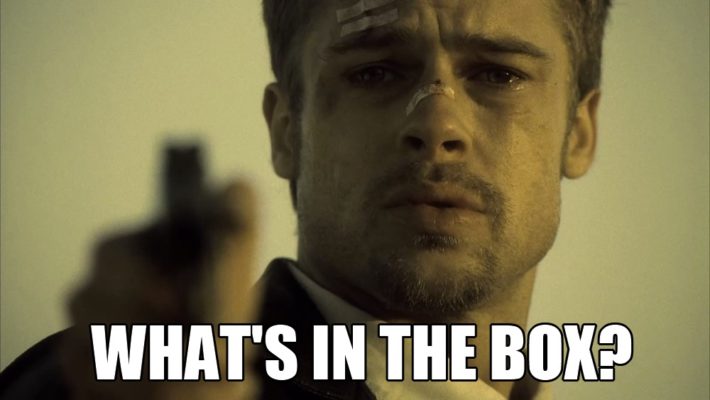
They already know what you’re offering and what the benefits are.
Now it’s time to succinctly break down the features of your product.
Again, I feel like Moz pulls this off flawlessly, so I’ll use this as an example:
I prefer breaking features down into bullet points or concise little sections like Moz does.
“Digestibility” is huge, and you want to present your product’s features in an easy-to-absorb, intuitive way.
You also want to touch on specifics to distinguish your product from competitors and to add a sense of value.
Here’s how I did this with Quick Sprout:
Keep it simple, but include a few key details that explain why your product is the bee’s knees.
Strong call to action (CTA)
By now, your prospects should understand what your product is, how it will benefit them, and what the features are.
Your final task is to tell them what to do next.
In other words, it’s time for your CTA.
You can liken this to battling a boss in the final level of a video game.
It’s arguably the most challenging aspect of the process, but if you’ve done what you were supposed to do in the previous steps, you should see a reasonable conversion rate.
Once again, simplicity reigns supreme, and I see no reason to complicate your CTA.
Here’s how I approach it on Quick Sprout:
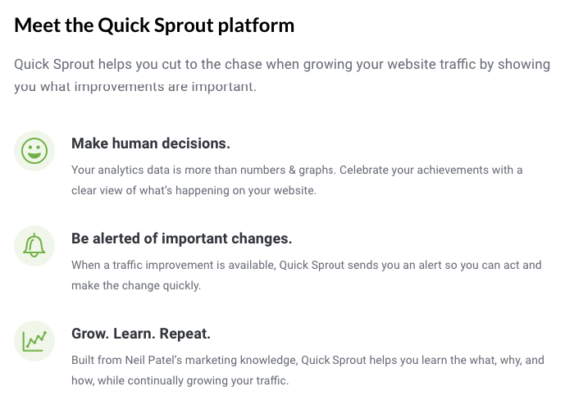
And here’s what it looks like on NeilPatel.com:
Notice that it’s very clear what action I want prospects to complete.
As always, I strongly recommend doing at least some basic A/B testing on your CTA to see what works best.
Some specific elements to test include:
- button style
- button color
- wording
- positioning
Be hella persuasive
Okay, now we’ve covered the basic structure of well-crafted copywriting.
The general structure of a landing page should be roughly as follows:
- Value proposition
- Benefits
- Features
- CTA
But how do you ensure you’re hitting all the right notes and being highly persuasive?
Obviously, the value proposition and benefits will offer some motivation, but here are some other things I’ve found to be impactful.
Make your content scannable
I’m not going to launch into a huge sermon about the importance of creating scannable content.
You probably already know people read online content differently than they do offline content.
But if you want to efficiently get prospects from Point A (your value proposition) to Point B (your CTA), it helps to make everything in-between easily scannable.
Luckily, the formula for scannable content is quite easy.
Just include headers, bullet lists, and a considerable amount of white space along the way.
Apple, being the savvy marketers they are, do this perfectly on their MacBook Pro landing page.
Here are a couple of screenshots:
It’s seamless.
Use persuasive words – Copywritin
An article on Business 2 Community talks about the three different brains we have:
- the new brain
- the middle brain
- the old brain
According to the article,
the old brain is the part that controls decisions, and it also happens to be the most primitive. In this way, the words you use to market to the old brain will often be the most direct, simple, arresting, visual words you have.
So if there was ever a copywriting hack, it’s using highly persuasive words that make the “old part of the brain light up.”
Here’s a list of those words:
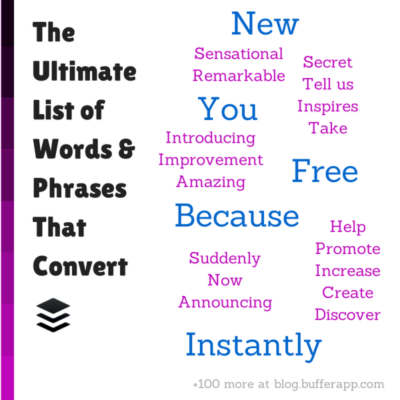
And according to research, the five most persuasive words in the English language are the ones in blue, which are:
- New
- You
- Free
- Because
- Instantly
Peppering these words throughout your copy in key locations should have a noticeable impact on conversions.
Copywriting Social proof
This is my last point, and it’s a biggie.
Incorporating social proof into your copy is the icing on the cake.
This was actually one of Robert Cialdini’s six principles of persuasion,
which maintains that people are especially likely to perform certain actions if they can relate to the people who performed the same actions before them.
I’m not going to go into all the gory details of social proof here.
But I will say that testimonials are usually your best bet, pound for pound.
You can also use things like:
- ratings
- media logos
- subscriber counts
- social connections (your number of followers)
- clients you’ve worked with
Just be practical, and provide whatever type of social proof you think would most persuade your prospects to take action.
Next Steps
Now that you have the basics read through all of the additional posts below to complete this entire guide and become a better copywriter in a flash.
Each post stands on its own and can be read separately, but to get the most out of this guide, it’s best to read through each one in its entirety.
Let’s continue with copywriting research which will help you learn how to better understand your customers and write more compelling copy, which is up first in our list.
- Copywriting Research
- Copywriting Strategies
- Copywriting Tips from 4 Legendary Books
- Long vs Short Copy: Which Is Better?
- Copywriting and Design
- Copywriting Call to Action
- Headline Writing 101The Formula for a Perfect Headline
- Headline Tips
- Stop Writing Boring Headlines
- Headline Trends
- Copywriting Tweaks
- Copywriting Testing
Putting It All Together – Copywriting
Once you have read all of the posts above to complete this entire guide you will have learned a LOT about copywriting.
To help tie everything together, we’d like to provide a checklist you can use for all of your copywriting projects.
This checklist will help you to remember what we’ve learned and enable you to employ all of the tactics included in this guide.
Here’s the list:
Start by researching your product and customers to catalogue the benefits and features of your product and to identify who your customers are.
- How would you describe the product?
- What’s unique/special about this product?
- What big benefit does it provide?
- What pain does it alleviate?
- What features are included, and what are the benefits of each?
- Who currently buys your product?
- Who would you like to buy your product?
- What is a typical customer like?
- What do customers love about your product?
Survey your customers to learn more about them and to find out what words they use to describe your product or service.
- What’s your job title?
- What company do you work for?
- How would you describe our product to a friend or colleague?
- What questions did you have before buying, i.e. what almost prevented you from making a purchase?
- What ultimately convinced you to buy this product?
- Which features were the most important to you when deciding whether or not to buy?
- What did you hope to accomplish by using this product?
Write an attention-grabbing headline that converts by employing the four u’s for headline writing.
- Your headline should be unique
- Your headline should be ultra-specific
- Your headline should convey a sense of urgency
- Your headline should be useful
Use the four persuasion techniques of professional copywriters.
- Emphasize benefits over features
- Be as specific as possible
- Target emotions
- Leverage testimonials
Make sure your copy isn’t focused on you and follow six more tips for better writing.
- Write conversationally
- Create a slippery slide
- Write quickly
- Use simple language
- Use short paragraphs
- Always get your copy edited
Follow five more secrets for powerful copy that convinces customers to buy.
- Make people feel like they belong
- Create a feeling of exclusivity
- Prove the value of your product
- Establish yourself as an authority
- Provide “reasons why”
Close the deal with your copy by using the following four tips.
- Use calls to action
- Create a sense of urgency
- Make a compelling offer
- Provide a guarantee
Know when to use long and short copy by following the rules below.
- Write as much as you need to write but no more
- Use long copy to answer more objections
- Remember that sometimes short copy is better
- Keep in mind that people read things that are interesting to them
Learn how to use design and copy to get optimum results.
- Use design to set the stage for your offer
- Remember that the point of your copy is to get read
- Use high contrast for fonts and backgrounds
- Make sure the font doesn’t blend into a background image
- Use graphic elements to draw readers’ attention to headlines and copy
- Employ reverse type sparingly
Finally, you need to test, test, and test some more to make sure your copy resonates with customers and convinces them to take action. Four test options are listed below.
- Subject lines
- Designs and layouts
- Concepts
- Offers
That ends up being quite a list. We hope that reading this guide will empower you to write copy that grows your business and increases response rates and conversions.
Key word:
- Copywriter và content writer
- Copywriting là gì
- Copywriting meaning
- Kỹ năng copywriting
- Cách viết copywriting
- Copywriting sách
- Freelance copywriter là gì
Related content:
How to Start a Blog That Makes Money (Lessons Learned)
How does the cloud works and something you need to know about it.
Hubspot free crm what is its concept and how does it works?

